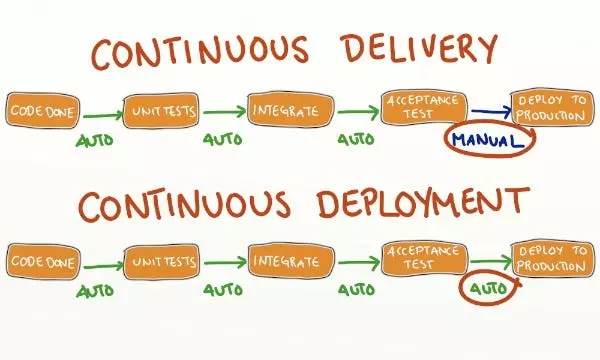Continuous Delivery & Continuous Deployment
Continuous Delivery and Continuous Deployment are practices in modern software development that streamline the release process. While they are closely related, they differ in their goals and levels of automation:
Continuous Delivery
Definition:
Continuous Delivery ensures that the codebase is always in a deployable state. Every change passes through automated tests and is pushed to a staging environment. However, deployment to production is a manual decision.
Key Points:
- Manual Trigger for Deployment:
Human intervention is required to push code from staging to production.
- Emphasis on Quality:
Focuses on robust automated testing and manual approval to ensure production readiness.
- Ideal Use Case:
When you want to control the timing of production releases, such as in regulated industries or for high-risk applications.
- Example:
After automated tests and staging, a release manager clicks a button to deploy to production.
Continuous Deployment
Definition:
Continuous Deployment goes a step further by automating the deployment process. Every successful change that passes automated tests is automatically deployed to production without manual intervention.
Key Points:
- Fully Automated:
No manual step exists between staging and production.
- Faster Feedback Loop:
Changes are live as soon as they pass the pipeline, enabling rapid iteration and feedback.
- Ideal Use Case:
Suitable for environments where frequent updates are needed, such as SaaS platforms or e-commerce sites.
- Example:
A developer commits code, tests pass, and the change is automatically deployed to production within minutes.
Key Differences
| Aspect | Continuous Delivery | Continuous Deployment |
|---|---|---|
| Deployment to Production | Manual Trigger | Fully Automated |
| Speed | Slower, as it waits for approval | Faster, as every change goes live |
| Risk Level | Lower, with more control | Higher, but mitigated with robust testing |
| Use Case | Regulated or sensitive environments | Dynamic and high-frequency environments |
Shared Foundations
Both practices rely on:
• Version control (e.g., Git).
• Automated testing.
• Continuous Integration (CI) pipelines.
• Monitoring and observability tools.
I relearned this today thought should share with everyone.
